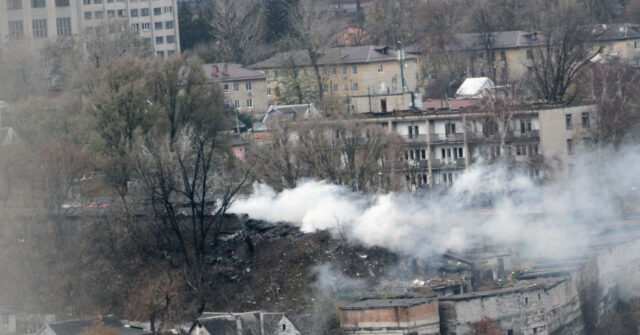We support our Publishers and Content Creators. You can view this story on their website by CLICKING HERE.

Ukraine says the “experimental intermediate-range ballistic missile” fired at the city of Dnipro on Thursday carried 36 “submunitions” and was travelling at Mach 11 as it struck.
The Ukrainian Ministry of Defence has published new claims about the new kind of ballistic missile that struck the central city of Dnipro in the early hours of Thursday morning. A statement said the missile, which left earth’s atmosphere in a ballistic arc after being launched from Russia’s Astrakhan region made the approximately 500 miles to the city in 15 minutes.
The missile had six re-entry vehicles, each of which carried a further six “submunitions” to the ground which were aimed at an industrial facility at the city, a feature common to ballistic missiles which use one large launch to deliver a larger number of ‘multiple independently targetable re-entry vehicles’. These expensive and complex weapons are designed to carry nuclear warheads, but can be fitted with conventional warheads, or even no warhead at all. It is not clear exactly what the “submunitions” were loaded with in this case.
Ukraine said as the weapons plunged down to earth they reached Mach 11 (roughly 8,400 miles an hour, depending on other factors).
The weapon was initially identified on Thursday by Ukraine’s air force as an intercontinental ballistic missile, and ICBM, a military acronym that thanks to the Cold War very much became a household name. While it appears to in fact be a Intermediate Range Ballistic Missile (IRBM), which is probably less meaningful for most, the distinction is essentially academic for Europeans given the entire continent is within IRBM range.
In that sense, exactly how much fuel a nuclear-capable ballistic missile carries doesn’t meaningfully change the threat it potentially poses. Nevertheless, Russia later claimed the weapon was the first use of a novel weapon, with President Putin identifying it as IRBM ‘Oreshnik’ (‘Hazel’). Asserting its potency, the Russian President claimed it was invulnerable to Western anti-air weapons, and Kremlin figures called it ‘hypersonic’.
Adding further context on Friday, Ukraine said this Oreshnik could be part of Russia’s ‘Kedr’ (‘Cedar’) missile programme which Moscow discussed publicly back in 2021. At that time it was described as the solid fuel “new-generation Kedr strategic missile system” which was at that point in “a deep R&D stage”. Kremlin media said the missile would be ready for “technical development” between 2023 and 2024 and would be ready for full operational rollout by 2030.
The Ukrainian claims followed others by the Pentagon on Thursday night saying the new ‘Kedr’ missile could be a development of the extant RS-26 Rubezh (‘Frontier’) ICBM, cutting down the craft to reduce range but presumably also cost for continental, rather than global, targets.
Deputy Pentagon Press Secretary Sabrina Singh Pentagon said: “I can confirm that Russia did launch an experimental intermediate-range ballistic missile. This IRBM was based on Russia’s RS-26 Rubezh intercontinental ballistic missile model… It could be refitted to certainly carry different types of conventional or nuclear warheads”.
While Moscow has attempted to taunt the West over the launch, boasting it would notify Ukraine of all future launches in advance as they couldn’t be shot down even with warning, and claiming President Volodymyr Zelensky had been left “scared” by the development, it is difficult to take Russian claims of missile invulnerability totally at face value. Indeed, as reported on Thursday:
The [allegedly hypersonic] Kinzhal missile was said to be so fast and manoeuvrable it was impossible to shoot down, however the makers of the United States Patriot missile shield system probably enjoyed a healthy bump in their order books from having shot down a number of them in the skies over Ukraine last year.
Nevertheless, a key complication with shooting down ballistic missiles is by the time they are within range of conventional anti-air systems, they are already close to directly above the target and plunging down from near-earth space, so even if they are destroyed, the falling debris is still over target. This is a particularly serious matter if the weapon is nuclear, and the debris radioactive.
The latest air defence systems overcome this by intercepting the ballistic missiles while in space. Indeed, the Israeli Arrow achieved the first known space battle victory in 2023 by shooting down an Iranian-made Ghadr-110 ballistic missile well out of Earth’s atmosphere at an altitude of over 62 miles. The effectiveness of the Arrow has won it attention abroad and Germany has placed a multi-billion dollar order for the system, one of the largest defence sales in Israel’s history.

 Conservative
Conservative  Search
Search Trending
Trending Current News
Current News 







